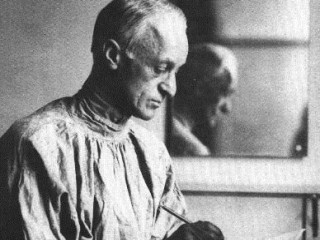
Harvey Williams Cushing biography
Date of birth : 1869-04-08
Date of death : 1939-10-07
Birthplace : Cleveland, Ohio, U.S.
Nationality : American
Category : Science and Technology
Last modified : 2011-06-06
Credited as : Neurosurgeon, pioneer of brain surgery, local anesthesia
The American neurosurgeon Harvey Williams Cushing developed operative techniques that made brain surgery feasible.
Harvey Cushing was born on April 8, 1869, in Cleveland, Ohio. He graduated from Yale University in 1891 and received a medical degree in 1895 from Harvard Medical School. After a year's internship at Massachusetts General Hospital he went to Johns Hopkins, where he was William Halsted's resident in surgery. From Halsted he learned meticulous surgical technique.
During a trip to Europe in 1900 Cushing worked with some of Europe's leading surgeons and physiologists, including Charles Scott Sherrington, Theodore Kocher, and Hugo Kronecker. They directed his attention to neurosurgery, to which he devoted the rest of his life. Shortly after his return to Johns Hopkins he was made associate professor of surgery. In 1902 he married Katharine Crowell.
In 1907 Cushing began studies of the pituitary gland. He unraveled many of the disorders affecting the gland and showed that a surgical approach to the pituitary was possible. In 1912 The Pituitary Body and Its Disorders was published. In that same year he accepted the Moseley professorship of surgery at Harvard and an appointment as surgeon in chief at Peter Bent Brigham Hospital in Boston. During World War I he served in France as director of Base Hospital No. 5. His wartime experiences formed the basis of a book, From a Surgeon's Journal (1936). Cushing's active affiliation with Harvard continued until 1932, when he was named professor emeritus. The following year he accepted the Sterling professorship of neurology at Yale.
Throughout his career Cushing studied brain tumors and published many important books on the subject, including: Tumours of the Nervus Acusticus and the Syndrome of the Cerebellopontile (1917); A Classification of the Tumours of the Glioma (1926), with P. Bailey; Tumours Arising from the Blood Vessels of the Brain: Angiomatous Malformations and Hemangioblastomas (1928), with Bailey; Intracranial Tumours (1932); and Meningiomas: Their Classification, Regional Behavior, Life History, and Surgical End Results (1938). He published numerous historical essays, and his biography of Sir William Osler (1925) received the Pulitzer Prize in 1926.
Cushing's use of local anesthesia in brain surgery was an outstanding achievement, as were his many special surgical techniques. In 1911 he introduced special sutures to control the severe bleeding that accompanies brain surgery and often made it impossible.
In 1937 Cushing accepted a position as director of studies in the history of medicine at Yale. He guided the development of a historical library to which he left his own excellent collection of historical books. He was especially interested in Andreas Vesalius, the 16th-century anatomist, and was at work on the Bio-Bibliography of Vesalius at the time of his death, on Oct. 7, 1939. The work was completed by his friends and published in 1943.
















